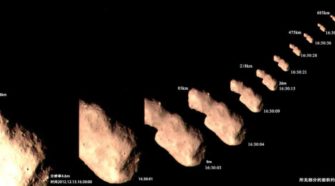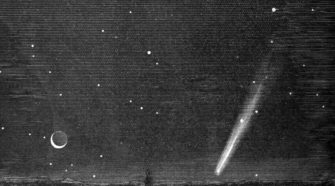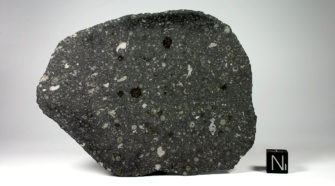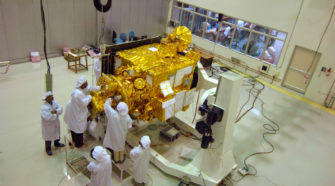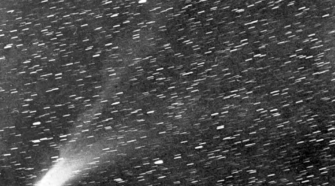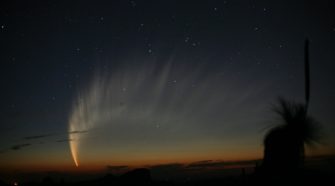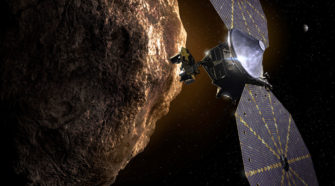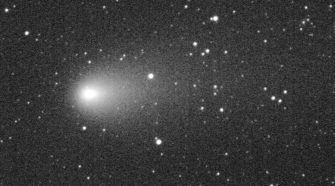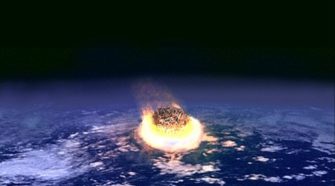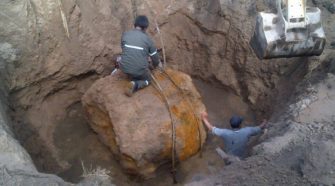Ice and Stone
This Week in History: Sept. 27-Oct. 3
SEPTEMBER 27, 1858: A British portrait painter and photographer, William Usherwood, takes a photograph of Comet Donati 1858 VI, the first photograph ever taken of a comet. No copies of Usherwood’s photograph are known to exist. Comet Donati is next week’s “Comet of the Week.” SEPTEMBER 27, 1990: The Hubble Space Telescope observes Comet Levy …
Comet of the Week: The Great Comet of 1882
Perihelion: 1882 September 17.72, q = 0.008 AU What can arguably be considered as one of the brightest and most spectacular comets of the entire 2nd Millennium was a Kreutz sungrazer, one of the most pre-eminent representatives of that class of objects that is the subject of a future “Special Topics” presentation. It was first …
Special Topic: Carbonaceous Chondrites
In an earlier “Special Topics” presentation I described how meteorites are classified based upon their respective compositions. As I indicated in that presentation, the majority of known meteorites are the “stony” meteorites composed primarily of various silicates, and of these, most contain small, roughly spherical particles called “chondrules” that are primarily made up of silicates …
This Week in History: September 20-26
SEPTEMBER 21, 2012: Two amateur astronomers, Vitali Nevski of Belarus and Artyom Novichonok of Russia, discover Comet ISON C/2012 S1 with a telescope of the International Scientific Optical Network located at Kislovodsk, Russia. Comet ISON was expected to become a brilliant object when near the sun and Earth in late 2013 but instead disintegrated as …
Comet of the Week: Delavan 1913f
Perihelion: 1914 October 26.77, q = 1.104 AU After the spectacular appearances of the Daylight Comet of 1910 and of Comet 1P/Halley later that same year – both of these objects having been discussed in previous “Ice and Stone 2020” presentations – the next few years brought some additional bright comets to Earth’s nighttime skies. …
Special Topic: Comet Tails
Of all the phenomena associated with comets, the one that more than any other gives them their beauty and their mystique is their tails. As recounted in a previous “Special Topics” presentation, the first recorded scientific observation of a comet concerned its tail: when observing the bright comet that appeared during the second half of …
This Week in History: September 13-19
SEPTEMBER 13, 1959: The then-Soviet Union’s Luna 2 spacecraft impacts the lunar surface slightly to the east of the Mare Imbrium. This was the first human spacecraft to reach the moon and the first spacecraft to impact another object in the solar system. SEPTEMBER 13, 1985: The U.S. Defense Department’s P78-1 satellite is deliberately destroyed …
Comet of the Week: 21P/Giacobini-Zinner 1984e
Perihelion: 1985 September 5.21, q = 1.028 AU The last comet discovered in the 19th Century was found on December 20, 1900, by the French astronomer Michel Giacobini from Nice Observatory, the fifth of twelve comets he discovered between 1896 and 1907. The comet was around 10th magnitude and was followed for two months, with …
Special Topic: Deflection Strategies
A common and persistent theme throughout “Ice and Stone 2020,” and indeed one of the primary reasons the “small bodies” of the solar system are of such high interest in the first place, is the threat they pose to Earth – or, at least, to our civilization and way of life here on Earth – …
This Week in History: September 6-12
SEPTEMBER 6, 1618: The German astronomer and mathematician Johannes Kepler observes Comet 1618 I (new style C/1618 Q1) – the first of three “Great Comets” that appeared that year – through a small telescope, the first recorded telescopic observation of a comet. SEPTEMBER 8, 1991: Tom Gehrels with the Spacewatch program in Arizona discovers the …

